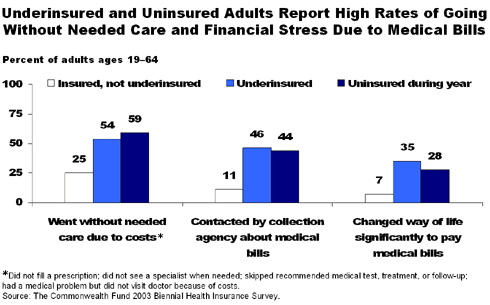In addition to the 45 million American adults who lacked health insurance at some point during 2003, another 16 million adults were underinsured—meaning their coverage provided inadequate protection against catastrophic health care expenses—Commonwealth Fund researchers find. An estimated total of 61 million adults, or 35 percent of individuals ages 19 to 64, had either no insurance, only sporadic coverage, or coverage that exposed them to high health costs during 2003.
In their article, "Insured But Not Protected: How Many Adults Are Underinsured?" (Health Affairs Web Exclusive, June 14, 2005), the Fund's Cathy Schoen, Michelle M. Doty, Ph.D., Sara R. Collins, Ph.D., and Alyssa L. Holmgren warn that recent trends in the health insurance market, such as higher cost-sharing and out-of-pocket expenses, could place increasing numbers of insured patients at risk. Insurance coverage that is too expensive and fails to provide adequate financial protection, they say, could undermine the use of effective medical care, jeopardize health, and threaten personal financial security. As a result, the distinction between insured and uninsured becomes blurred.
The extent of the underinsured problem has not been assessed since a 1995 study, partly due to the lack of a working definition. Using a 2003 Commonwealth Fund survey, Schoen, the study's lead author and the Fund's senior vice president for research and evaluation, defined an underinsured person as one who has health coverage all year but also meets one of three conditions: 1) annual out-of-pocket medical expenses amount to 10 percent or more of income; 2) for low-income adults with income under 200 percent of the federal poverty level, out-of-pocket medical expenses amount to 5 percent or more of income; or 3) health plan deductibles equal or exceed 5 percent of income. 
Under Schoen's comprehensive definition, 12 percent of adults who had coverage all year in 2003—nearly 16 million people—were underinsured. Relative to those with adequate coverage, the underinsured were significantly more likely to go without care because of costs. More than one-half of the underinsured (54%) and uninsured (59%) failed to fill a prescription, skipped a key medical exam or follow-up, failed to visit a doctor for a medical problem, and/or did not get needed care from a specialist.
Levels of financial stress among the underinsured rivaled those among the uninsured. Nearly one-half (46%) of the underinsured were contacted by a collection agency for medical bills and more than one-third (35%) said they had to change their way of life to pay medical bills.
Compared with the adequately insured, the underinsured were less likely to have prescription drug coverage, dental coverage, or vision benefits and more likely to face deductibles of $500 or more.
"Unless this country starts to pay attention to health benefit design, it is going to be harder to distinguish the insured from the uninsured," said Fund president Karen Davis.
In their article, "Insured But Not Protected: How Many Adults Are Underinsured?" (Health Affairs Web Exclusive, June 14, 2005), the Fund's Cathy Schoen, Michelle M. Doty, Ph.D., Sara R. Collins, Ph.D., and Alyssa L. Holmgren warn that recent trends in the health insurance market, such as higher cost-sharing and out-of-pocket expenses, could place increasing numbers of insured patients at risk. Insurance coverage that is too expensive and fails to provide adequate financial protection, they say, could undermine the use of effective medical care, jeopardize health, and threaten personal financial security. As a result, the distinction between insured and uninsured becomes blurred.
The extent of the underinsured problem has not been assessed since a 1995 study, partly due to the lack of a working definition. Using a 2003 Commonwealth Fund survey, Schoen, the study's lead author and the Fund's senior vice president for research and evaluation, defined an underinsured person as one who has health coverage all year but also meets one of three conditions: 1) annual out-of-pocket medical expenses amount to 10 percent or more of income; 2) for low-income adults with income under 200 percent of the federal poverty level, out-of-pocket medical expenses amount to 5 percent or more of income; or 3) health plan deductibles equal or exceed 5 percent of income.

Under Schoen's comprehensive definition, 12 percent of adults who had coverage all year in 2003—nearly 16 million people—were underinsured. Relative to those with adequate coverage, the underinsured were significantly more likely to go without care because of costs. More than one-half of the underinsured (54%) and uninsured (59%) failed to fill a prescription, skipped a key medical exam or follow-up, failed to visit a doctor for a medical problem, and/or did not get needed care from a specialist.
Levels of financial stress among the underinsured rivaled those among the uninsured. Nearly one-half (46%) of the underinsured were contacted by a collection agency for medical bills and more than one-third (35%) said they had to change their way of life to pay medical bills.
Compared with the adequately insured, the underinsured were less likely to have prescription drug coverage, dental coverage, or vision benefits and more likely to face deductibles of $500 or more.
"Unless this country starts to pay attention to health benefit design, it is going to be harder to distinguish the insured from the uninsured," said Fund president Karen Davis.